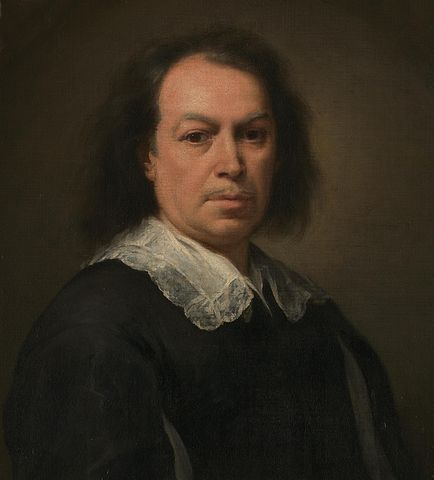
Born: Late December 1617, Seville
Died: 3 April 1682 (aged 64)
Period: Baroque
The Life of Bartolome Esteban Murillo
Bartolomé Esteban Murillo, born in late December 1617 in Seville, Spain, emerged as one of the most influential Spanish painters of the Baroque era. Renowned for his religious works, genre scenes, and portraits, Murillo’s artistry is characterized by its warm, soft tones, tender emotional expressions, and dramatic use of light and shadow, encapsulating the spiritual fervor and humanism of the Counter-Reformation period.
Murillo’s early life was marked by tragedy, with both of his parents dying by the time he was ten, leaving him and his siblings in the care of their aunt and uncle. Despite these hardships, Murillo showed an early inclination towards art, apprenticing under Juan del Castillo, a relative and painter, from whom he learned the fundamentals of painting.
By the 1640s, Murillo began to establish himself in Seville, receiving commissions for a series of paintings for the Franciscan convent of Seville. These works, which depicted the lives of saints and religious visions, were instrumental in his rise to prominence, showcasing his skill in conveying spiritual depth and the human emotional experience.
Murillo’s style evolved over the years, initially influenced by the naturalism of Spanish and Flemish painting, and later, by the Roman and Venetian schools, incorporating a more luminous palette and a softer, more idealized approach to figures. His ability to blend these influences created a distinctive style that made him a central figure in the Seville school of painting.
Beyond his religious works, Murillo is also celebrated for his depictions of contemporary life in Seville, particularly his genre scenes of street urchins and beggars. These paintings, while often imbued with a sense of idealism, reflect a genuine compassion and interest in the lives of the common people, a rarity among his contemporaries.
Murillo’s later years were marked by continued success and the establishment of an academy in Seville, reflecting his status as a leading artist in the city. Despite a fall from a scaffold while working on a commission in the Capuchin church in Cádiz, which led to his death on April 3, 1682, Murillo’s influence persisted. His works were highly sought after, not only in Spain but across Europe, influencing generations of artists.
Today, Bartolomé Esteban Murillo is remembered as a master of the Spanish Baroque, whose works continue to be celebrated for their beauty, emotional resonance, and spiritual depth, encapsulating the complexity of human and divine experience.
Bartolome Esteban Murillo‘s Notable Works
Bartolomé Esteban Murillo, a pivotal figure of the Spanish Baroque period, is celebrated for his religious paintings, genre scenes, and portraits that reflect a unique blend of realism and spirituality. Here are ten of his most famous works:
- The Immaculate Conception of Los Venerables (circa 1678) – One of Murillo’s several interpretations of the Immaculate Conception, showcasing his ability to convey celestial purity and light.
- The Young Beggar (circa 1650) – A genre painting that depicts a street urchin cleaning a foot, highlighting Murillo’s empathy for the poor and his skill in portraying everyday life.
- The Holy Family with a Little Bird (circa 1650) – A tender depiction of the Virgin Mary, Joseph, and the Christ Child, notable for its domestic intimacy and the detailed observation of nature.
- Two Women at a Window (circa 1655-1660) – A charming genre scene where a young woman and an older companion peek from a window, showcasing Murillo’s talent for capturing human expressions and social interactions.
- The Adoration of the Shepherds (circa 1650) – A luminous and tender representation of the shepherds worshipping the newborn Christ, demonstrating Murillo’s mastery in depicting divine light and human emotion.
- Saint Justa and Saint Rufina (circa 1665) – Portrays the patron saints of Seville holding the Giralda tower, exemplifying Murillo’s ability to blend religious iconography with naturalistic detail.
- The Annunciation (circa 1660-1665) – A depiction of the Angel Gabriel announcing to Mary that she will bear the Son of God, notable for its graceful figures and divine atmosphere.
- The Prodigal Son series (circa 1660s) – A series of paintings that narrate the parable of the Prodigal Son, highlighting Murillo’s skill in storytelling and his sensitivity to human emotion.
- The Virgin of the Rosary (circa 1650-1655) – Depicts the Virgin Mary presenting the rosary to Dominic of Guzman, surrounded by angels, demonstrating Murillo’s devotion to the Virgin and his skill in composing complex scenes.
- Self-Portrait (circa 1670-1673) – One of the few known self-portraits by Murillo, offering insight into the artist’s appearance and his self-perception at the height of his career.
Murillo’s works are celebrated for their warmth, piety, and the compassionate portrayal of his subjects, securing his legacy as one of the greatest painters of the Spanish Golden Age.